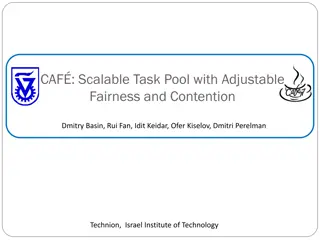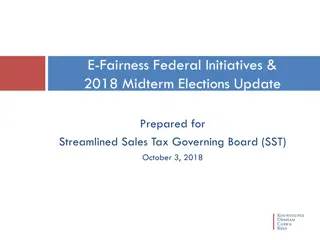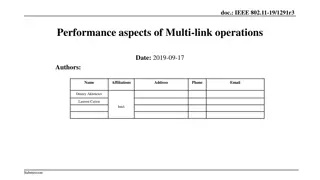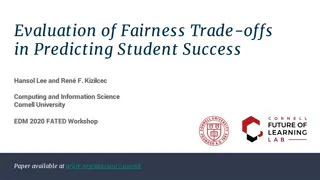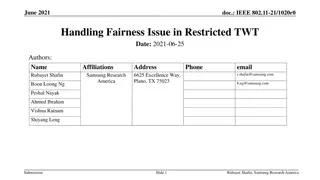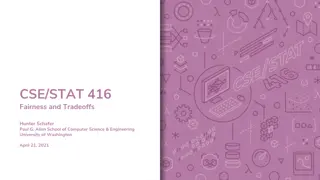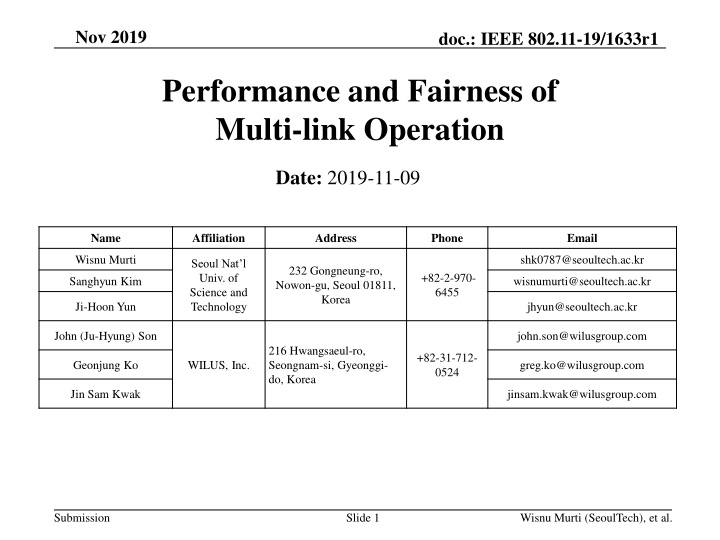
Performance and Fairness of Multi-Link Operation in IEEE 802.11
Explore the performance and implications of multi-link aggregation in IEEE 802.11 networks, focusing on power leakage, synchronous operations, and channel access operations. Understand how power leakage impacts channel assessments and learn about different modes of channel access operations for improved network efficiency and throughput.
Download Presentation

Please find below an Image/Link to download the presentation.
The content on the website is provided AS IS for your information and personal use only. It may not be sold, licensed, or shared on other websites without obtaining consent from the author. If you encounter any issues during the download, it is possible that the publisher has removed the file from their server.
You are allowed to download the files provided on this website for personal or commercial use, subject to the condition that they are used lawfully. All files are the property of their respective owners.
The content on the website is provided AS IS for your information and personal use only. It may not be sold, licensed, or shared on other websites without obtaining consent from the author.
E N D
Presentation Transcript
Nov 2019 doc.: IEEE 802.11-19/1633r1 Performance and Fairness of Multi-link Operation Date: 2019-11-09 Name Affiliation Address Phone Email Wisnu Murti shk0787@seoultech.ac.kr Seoul Nat l Univ. of Science and Technology 232 Gongneung-ro, Nowon-gu, Seoul 01811, Korea +82-2-970- 6455 Sanghyun Kim wisnumurti@seoultech.ac.kr Ji-Hoon Yun jhyun@seoultech.ac.kr John (Ju-Hyung) Son john.son@wilusgroup.com 216 Hwangsaeul-ro, Seongnam-si, Gyeonggi- do, Korea +82-31-712- 0524 Geonjung Ko WILUS, Inc. greg.ko@wilusgroup.com Jin Sam Kwak jinsam.kwak@wilusgroup.com Submission Slide 1 Wisnu Murti (SeoulTech), et al.
Nov 2019 doc.: IEEE 802.11-19/1633r1 Introduction EHT STAs are expected to support multi-link aggregation Benefits of multi-link aggregation are Increased peak throughput Reduced latency and jitter Power leakages between links may or may not be present If power leakage is present, it affects the clear channel assessments of other links The following channel access operations have been discussed [1][2][3]: Synchronous operation Asynchronous operation Semi-asynchronous operation (aka synchronous without primary link [2], mixed synchronous and asynchronous [3]) The performance of these channel access operations may be affected by (1) existence of power leakage; (2) coexistence with legacy system; and (3) coexistence with EHT BSSs using different channel-access operation Submission Slide 2 Wisnu Murti (SeoulTech), et al.
Nov 2019 doc.: IEEE 802.11-19/1633r1 Multi-link and Power Leakage TXOP TXOP 2 1 0 4 3 2 1 0 Link 1 No Power Leakage Case TXOP Link 2 4 3 2 1 0 8 7 6 5 4 3 2 1 0 TXOP TXOP 2 1 0 4 3 2 1 0 Link 1 Power Leakage Case 8 7 6 5 4 LEAKAGE LEAKAGE Link 2 3 2 1 BUSY due to power leakage from Link 1 Link with power leakage Other link will sense its medium as BUSY if a neighboring link is transmitting Link with no power leakage Other link will NOT sense a neighboring link's transmission, thus still can sense its medium as IDLE Submission Slide 3 Wisnu Murti (SeoulTech), et al.
Nov 2019 doc.: IEEE 802.11-19/1633r1 Synchronous Operation TXOP TXOP 2 1 0 4 3 2 1 0 Link 1 BUSY TXOP Link 2 Perform back off procedure only on a primary link Perform short CCA on secondary link(s) just before the backoff completion of a primary link IDLE transmit on this secondary link too BUSY does not transmit on this secondary link Ideal to be used in links with power leakage Submission Slide 4 Wisnu Murti (SeoulTech), et al.
Nov 2019 doc.: IEEE 802.11-19/1633r1 Asynchronous Operation TXOP TXOP 2 1 0 4 3 2 1 0 Link 1 No Power Leakage Case TXOP TXOP Link 2 8 7 6 5 4 3 2 1 0 2 1 0 TXOP LEAKAGE 7 6 5 4 4 3 2 1 0 Link 1 Power Leakage Case TXOP 6 5 4 3 LEAKAGE Link 2 8 7 2 1 0 Perform contention independently on individual links Perform transmission independently on individual links Ideal to be used in links without power leakage Submission Slide 5 Wisnu Murti (SeoulTech), et al.
Nov 2019 doc.: IEEE 802.11-19/1633r1 Semi-asynchronous Operation Link 1 4 BUSY TXOP 7 6 5 4 TXOP 3 2 1 0 No Power Leakage Case Link 2 TXOP TXOP TXOP 3 2 1 0 2 1 0 5 4 LEAKAGE BUSY 4 TXOP TXOP 3 2 1 0 Link 1 7 6 Power Leakage Case TXOP TXOP Link 2 5 4 3 2 1 0 TXOP 2 1 0 Perform contention independently on individual links Perform short CCA on the other link(s) just before completion of its backoff IDLE transmit on other link too BUSY does not transmit on other link Can be be used in links with or without power leakage Submission Slide 6 Wisnu Murti (SeoulTech), et al.
Nov 2019 doc.: IEEE 802.11-19/1633r1 Semi-asynchronous Operation fairness issues Free-riding link s resumed backoff procedure after transmission impacts fairness with legacy stations Need to design semi-asynchronous operation to support coexistence We discuss different options for a free-riding link's backoff procedure after transmission Default: Resume backoff without changing its backoff count Option 1: Repick a new backoff count number Option 2: Switch to another CW set for a predetermined time period [similar to MU EDCA operation in 11ax] Submission Slide 7 Wisnu Murti (SeoulTech), et al.
Nov 2019 doc.: IEEE 802.11-19/1633r1 Semi-asynchronous Operation Option 1 Link 1 4 BUSY 7 6 5 4 3 TXOP 3 2 1 0 No Power Leakage Case Link 2 TXOP 9 8 7 6 5 TXOP 2 1 0 5 4 repick backoff number LEAKAGE TXOP BUSY 4 3 2 1 0 Link 1 7 6 5 4 Power Leakage Case TXOP TXOP 9 8 7 6 Link 2 5 4 3 2 2 1 0 repick backoff number Fairness Option 1 After transmission on multiple links, each free-riding link (Link 2) repicks a new backoff counter Submission Slide 8 Wisnu Murti (SeoulTech), et al.
Nov 2019 doc.: IEEE 802.11-19/1633r1 Semi-asynchronous Operation Option 2 Link 1 BUSY 4 TXOP BUSY 7 6 5 3 2 1 0 No Power Leakage Case Link 2 TXOP TXOP 18 17 3 2 1 0 TXOP 2 1 0 5 4 timeout LEAKAGE repick from CW Set B TXOP BUSY 4 3 2 1 0 BUSY Link 1 6 5 7 Power Leakage Case TXOP TXOP TXOP 18 17 Link 2 5 4 3 2 1 0 2 1 0 timeout repick from CW Set B Fairness Option 2 After transmission on multiple links, each free-riding link (Link 2) switches from CW Set A to CW Set B for a predetermined time period CW Set A default set (e.g. [16 .. 1024]) CW Set B higher CWmin and/or CWmax than Set A (e.g. [32 .. 2048]) Switch back to CW Set A after the time period expires Submission Slide 9 Wisnu Murti (SeoulTech), et al.
Nov 2019 doc.: IEEE 802.11-19/1633r1 Simulation Setup BSS Setup 1 EHT BSS with 1 AP and 1 non-AP STA, both are multi-link aggregation enabled 0~10 legacy OBSSs, each consists of 1 AP and 1 non-AP STA (single link) in each band TX Setup Transmission with A-MPDU (up to 64 MPDUs), 1 MPDU = 1500 Bytes Both EHT BSS and legacy OBSSs are in full-buffer DL operation Using MCS 9 and 80 MHz bandwidth for each band Setup for semi-asynchronous operation Option 2 CW Set A [16 .. 1024] CW Set B [32 .. 2048] Timeout time 1ms Submission Slide 10 Wisnu Murti (SeoulTech), et al.
Nov 2019 doc.: IEEE 802.11-19/1633r1 Throughput Comparison without power leakage with power leakage Synchronous operation (SYNC) Not heavily affected by power leakage Performs worst in OBSS scenarios Asynchronous operation (ASYNC) Highly affected by power leakages, better performance without power leakage Semi-asynchronous operation (SA) Highest throughput with and without power leakage Performs best in crowded conditions with many legacy OBSSs Submission Slide 11 Wisnu Murti (SeoulTech), et al.
Nov 2019 doc.: IEEE 802.11-19/1633r1 Coexistence Simulation Scenario Fairness with Legacy Legacy Legacy Legacy EHT Band 1 Link 1 Link 1 Band 1 Link 1 Link 1 Band 2 Link 2 Link 2 Link 2 Band 2 Link 2 Legacy Legacy Legacy (EHT vs. Legacy) (Legacy only) Fairness with legacy Legacy only: 2 legacy BSSs in each band (each BSS is 1 AP + 1 non-AP STA) EHT and legacy: 1 EHT BSS using both bands and 1 legacy BSS in each band (2 legacy BSSs in total) Coexistence between different EHT multi-link channel access operations 2 EHT BSSs (1 AP and 1 non-AP STA), each using its own channel access operation Coexistence bet n different EHT multi-link channel access EHT 2 EHT 1 Band 1 Link 1 Link 1 Band 2 Link 2 Link 2 (EHT vs. EHT) Submission Slide 12 Wisnu Murti (SeoulTech), et al.
Nov 2019 doc.: IEEE 802.11-19/1633r1 Fairness with Legacy System with power leakage without power leakage EHT BSS using SA is more aggressive against legacy BSS compared to SYNC and ASYNC Both fairness options of SA (Option 1 and 2) can be used to alleviate the fairness problem with legacy system Submission Slide 13 Wisnu Murti (SeoulTech), et al.
Nov 2019 doc.: IEEE 802.11-19/1633r1 Coexistence between Different EHT Channel Access Operations without power leakage with power leakage SA is more aggressive than SYNC and ASYNC Both fairness options of SA (Option 1 and 2) can alleviate the fairness problem with other channel access operations Submission Wisnu Murti (SeoulTech), et al. Slide 14
Nov 2019 doc.: IEEE 802.11-19/1633r1 Conclusions The performance of the channel access operations for multi-link aggregation is affected by (1) with/without power leakage between links; (2) coexistence with legacy system; and (3) coexistence with EHT BSSs using different multi-link channel-access operation Semi-asynchronous operation performs better than synchronous and asynchronous operations with and without power leakage for a wide range of OBSS crowdedness Semi-asynchronous operation is more aggressive in channel access than synchronous and asynchronous operations, thus having a coexistence problem with legacy BSSs as well as with EHT BSSs using other channel access operation Semi-asynchronous operation with the proposed backoff procedure modification can alleviate the coexistence problem Submission Slide 15 Wisnu Murti (SeoulTech), et al.
Nov 2019 doc.: IEEE 802.11-19/1633r1 References [1] 11-19-1291 Performance aspects of Multi-link operations [2] 11-19-1116 Channel Access in Multi-band operation [3] 11-19-1678 Multiple Link Asynchronous and Synchronous Transmission Submission Slide 16 Wisnu Murti (SeoulTech), et al.
Nov 2019 doc.: IEEE 802.11-19/1633r1 Appendix : Fairness with Legacy System 25% load on legacy STAs without power leakage with power leakage Submission Slide 17 Wisnu Murti (SeoulTech), et al.
Nov 2019 doc.: IEEE 802.11-19/1633r1 Appendix : Fairness with Legacy System 50% load on legacy STAs without power leakage with power leakage Submission Slide 18 Wisnu Murti (SeoulTech), et al.
Nov 2019 doc.: IEEE 802.11-19/1633r1 Appendix : Fairness with Legacy System 75% load on legacy STAs without power leakage with power leakage Submission Slide 19 Wisnu Murti (SeoulTech), et al.






